Menus
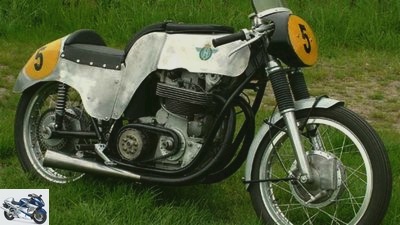
Jurgen Noell
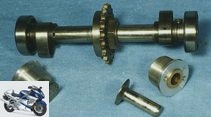

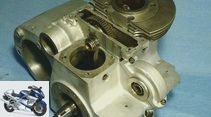
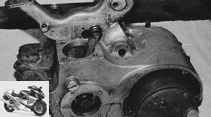
12th photos
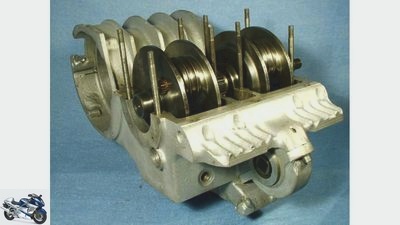
Jurgen Noell
1/12
The crankshaft is inserted into the upturned housing half; The slim design of the parallel twin is easy to see.
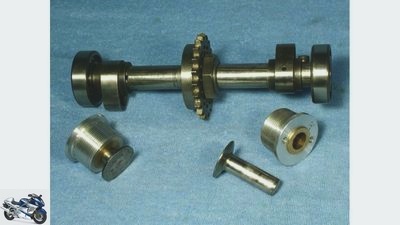
Jurgen Noell
2/12
Searched for a long time, then built it myself: one of the camshafts with drive pinion, valve lifters and tappet guides.
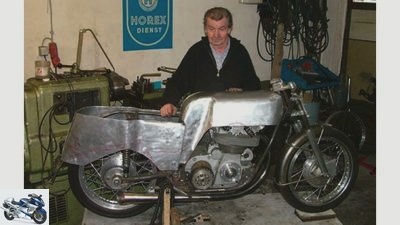
Jurgen Noell
3/12
Horex collector and restorer Reinhard Jutzi in his workshop adjusting the aluminum cladding. The engine is already in the chassis.
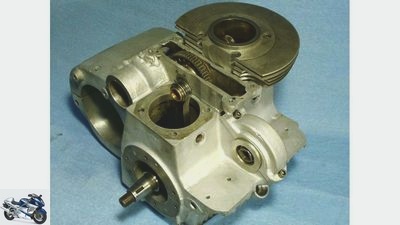
Jurgen Noell
4/12
The shaft for the camshaft drive is located between the cylinders.
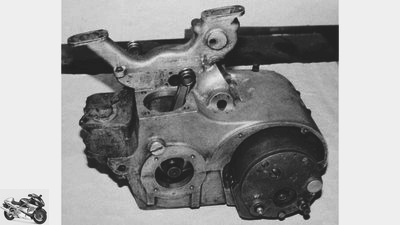
Jurgen Noell
5/12
The starting point: a 30-year-old engine housing without cylinders and heads, discovered at Veterama.
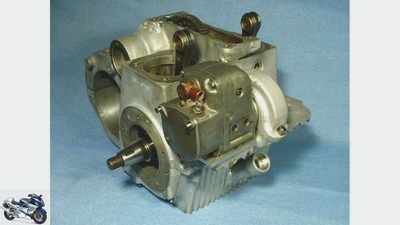
Jurgen Noell
6/12
The first of the two Bosch magnetos is already installed. A common gear drives the two.
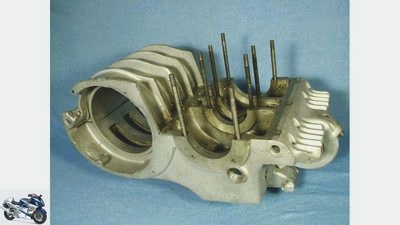
Jurgen Noell
7/12
The crankcase, turned upside down here, and the gearbox mount are made of one piece.

Jurgen Noell
8/12
Drive and bearing of the camshafts. Exposed hairpin springs close the valves.
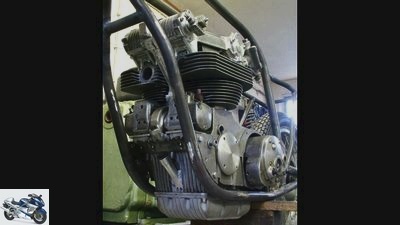
Jurgen Noell
9/12
This is where the towering two-cylinder sits in the newly constructed chassis. The Hurth gearbox, the adapted oil pan and the ignition magnets in front of the cylinders are clearly visible.
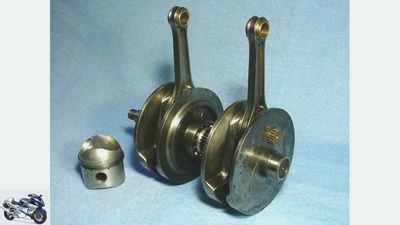
Jurgen Noell
10/12
The 360-degree crankshaft is connected by means of Hirth gears. It has four main camps.
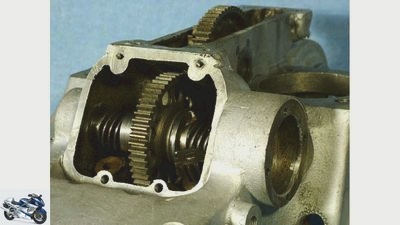
Jurgen Noell
11/12
The drive for the two oil pumps, which are driven by worm wheels, is located behind the timing chain shaft.
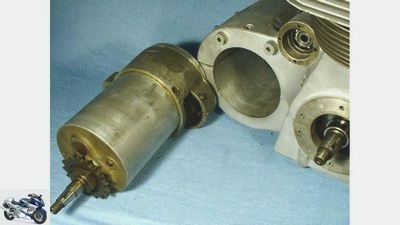
Jurgen Noell
12/12
What looks like an alternator here is the Hurth racing gearbox. The eccentrically mounted gear unit can be turned to adjust the tension of the primary chain.
Technology: Hoske-Horex 500
The racing emperor is booming again
Content of
Their last race was over half a century ago. Reinhard Jutzi has rebuilt the double-cam racing imperator.
Jurgen Noell
Builder Reinhard Jutzi with the legendary double-cam racing Horex.
His voluminous tanks became famous as Hoske tanks, his silencers as Hoske bags: Ernst Hoske, born in 1921, was a successful motorcycle racer in a BMW. It is less well known that he also competed on Horex. At the latest after podium places in 1949 and 1950 on the Grenzlandring and his victory in the half-liter class in 1950 at the Feldberg race, Ernst Hoske became aware of the Horex factory. Because the Bad Homburg company was also considering getting back into road racing.
In the first post-war years there was already a new Horex racing machine with a 500cc dohc two-cylinder engine, the design drawings of which go back to 1949. But the motorcycle did not get beyond a few trial runs. After the war, every available employee was needed to keep up with the rapid development of the motorcycle business. Another reason why Horex did not develop this dohc racing machine to the end, but replaced it with a new ohc design as early as 1951, was probably the lack of series production to the planned top model, namely the new Imperator.
There is no question that a production motorcycle whose engine would be successful in racing would appeal to customers in particular. The double-cam Horex had all the characteristics of a modern racing machine: It had a double-loop tubular frame with a rear swing arm. The air-cooled half-liter engine had two separate, cast aluminum cylinders and cylinder heads with projecting cooling fins. With a 65 mm bore and 75 mm stroke, the racing engine produced around 50 hp at 8500 rpm. The timing chain ran in an aluminum shaft between the cylinders, and two separate ignition magnets supplied the ignition voltage.
Only when the near-series ohc machines did not achieve any noteworthy racing successes in the 1951 season, a new racing engine was developed under Horex chief designer Hermann Reeb. It was based on the planned series engine with two overhead camshafts. At the same time, the Horex works commissioned Ernst Hoske to develop a comparison vehicle from the old dohc racing machine. In addition to the motorcycle itself, the factory gave him the housing parts for a second engine. When Hoske first used this machine in a race on the Avus in 1952, the trade press was enthusiastic.
The MOTORRAD wrote at the time: "He has set up a machine that is peppered from front to back with surprising innovations and special features." The reporter obviously did not know that the Bad Homburg company Ernst Hoske had provided the engine parts of the dohc factory machine from 1949/50, which had hardly appeared. The special features, for example the fuel tank located under the driver’s seat and the narrow crankcase with the ignition magnets in front of and the oil pumps behind the cylinders, must, however, be attributed to the Horex engineers.
This first double-cam Horex brought Hoske to the start several times during the season. It turned out to be extremely fast, but not yet stable. He fought for a long time to be more stable, but finally put the machine in a corner, resigned. About 30 years later, parts of the second Horex racing engine reappeared at the Veterama in Mannheim. They came from the estate of Ernst Hoske, who died in 1976. But since nobody knew what to do with it, there was no buyer. When Horex fan Reinhard Jutzi found out about the existence of these parts, he found their owners on the Veterama the following year. But it would be a few years before Jutzi could call the housing and the associated crankshaft his own."At some point it will roar again, and maybe even drive a racing machine", Jutzi put his decision into words.
Words follow deeds: the rebuilding of the legendary Hoske-Horex
archive
Ernst Hoske around 1950 on his legendary double-cam Horex with the number 5.
20 years later, Jutzi had at least found the right cylinders, including cylinder heads, and tracked down the original Hurth racing transmission, which was also used in the prototypes of the first Imperator models. Jutzi had followed up innumerable clues in search of a needle in a haystack. But long before he had all the pieces together, the sources seemed to have dried up. There was obviously nothing left. So Jutzi, who had meanwhile taken his professional retirement, reconstructed the frame based on the few photos that exist of the machine. Wheels and brakes were available, and a usable front fork was also available.
In 2004, half a century after Ernst Hoske had shut down the Renn-Horex, the chassis was complete again – but important parts of the engine were still missing. "I couldn’t wait another 20 years if I wanted to drive the machine myself", explains Jutzi today. So he decided to make the missing components of the engine himself. In his mechanical workshop, Jutzi started the machines: he gradually milled the two halves of the timing chain shaft from aluminum blocks from the base of a beer crate. He also made its top cover and the camshaft housing, which was welded from several elements. He also produced the timing chain tensioner himself, as did the cover for the drive for the two ignition magnets and the tappet guides with their mounts. And because the search for camshafts was unsuccessful, Jutzi also built these himself. Thank goodness, connecting rods were still mounted on the crankshaft and even had completely new bearings. Jutzi was able to continue using it after he had cleaned it thoroughly.
Jurgen Noell
The Hoske-Horex is taking shape: the completed twin cam is already in the simulated chassis.
The forged pistons, valve springs and other parts were found in Switzerland. The two magnetos came "from somewhere". Jutzi improvised the oil pan from that of a Horex Imperator, which he adapted to the engine using an intermediate plate. The oil pump from a BMW R 51/2 fitted right away, apart from the drive wheels. So Jutzi made a new drive worm and the corresponding worm wheel. At some point in the early summer of 2007, he had finished working on the engine to the point where he could put it in the chassis.
What a monster of a racing engine! No wonder that the Horex designers back then did not place the fuel tank above the engine, but behind it. As a result, the restorer asked what type of fuel pump he should use to deliver the fuel to the higher-placed Dell’Orto carburettors; a mechanical or, as was the case with the original, an electrical one? Jutzi decided on a third option: he arranged a two-liter intermediate tank above the engine, which a vacuum-controlled petrol pump from a scooter supplies with fuel from the main tank.
Jurgen Noell
Reinhard Jutzi’s name is emblazoned on the rev counter of the resurrected Hoske-Horex.
Reinhard Jutzi is not only at home in the machining of metal, but also knows how to work on sheet metal parts. He demonstrated this with the hand-ironed aluminum sheet metal cladding: within a few days he was pressing, casting, bending and welding a cladding from a sheet of sheet metal as if he had never done anything else. The only parts of the motorcycle that Jutzi did not buy as originals and did not reproduce himself were the upholstery for the seat and trim. "I know a good saddler there", he smiles. The Horex fan, who began collecting the twin-cam two-cylinder factory racing machines from Bad Homburg after his active racing career in the 1970s, has closed the last gap in his collection with this model. There weren’t any more two-cylinder racing models from Horex.
Related articles
-
Harley-Davidson Board Tracker: Racing machines from 1918
Winni Winfried Scheibe Scene: Harley-Davidson board tracker Historic racing machine from 1918 Content of Andreas Wehrmann’s dream was a historic racing…
-
Horex 17th photos Horex 1/17 Number one: This Silver Edition is clearly the first of 33. Horex 2/17 A real eye-catcher: the two-tone aluminum spoke rims…
-
Car versus motorcycle: Skoda Octavia WRC versus KTM 525 EXC Racing in rally test
wolf Car versus motorcycle Skoda Octavia WRC versus KTM 525 EXC Racing in rally test When a World Rally Car and a KTM 525 EXC, i.e. off-road driving…
-
Test: Norton 18 H racing machine
Noll Test: Norton 18 H Racing motorcycle from the 1920s Content of In the 1920s, the Norton 18 H was one of the most successful half-liter machines – and…
-
TYGA Street NX-5 Honda RS 250 R-S Street racing motorcycle
TYGA performance 34 photos TYGA performance 1/34 In the 1990s, the Honda RS250R was a hot topic in the 250cc Grand Prix class. TYGA performance 2/34 In…
-
Naked bike Horex VR6 Roadster in the driving test
Horex Premiere: Horex VR6 Roadster Horex VR6 Roadster in the test Content of Innovative and courageous, German engineers show what is possible in engine…
-
Horex VR6 Classic HL driving report
8th photos Jorg Kunstle 1/8 Due to the purchase of Horex by 3C-Carbon and the mastermind Karsten Jerschke, the project of the tightly built…
-
Horex VR6 Roadster in the driving report
Bilski 13 photos Bilski 1/13 Horex VR6 Roadster in the driving report. Bilski 2/13 Horex VR6 Roadster in the driving report. Bilski 3/13 Horex VR6…
-
Driving report TM Racing 400 F
Driving report TM Racing 400 F Who sows the wind… …will reap storm. The off-road scene sets the sails in terms of four-stroke technology….
-
Horex VR6 Classic in the driving report
Photo: manufacturer 13 photos Horex 1/13 The Horex Classic does what the driver tells it to do. Steers quite precisely, does not touch down too early…